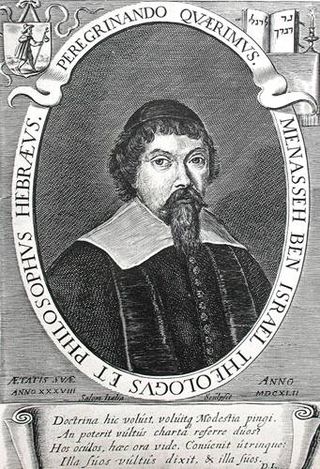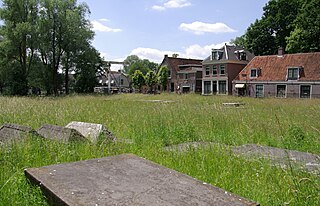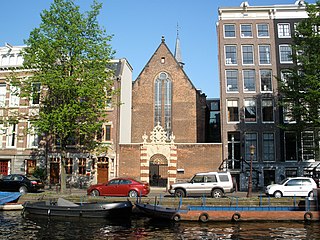
Baruch (de) Spinoza was a philosopher of Portuguese-Jewish origin, born in Amsterdam, the Dutch Republic, and mostly known under his Latinized pen name Benedictus de Spinoza. One of the foremost and seminal thinkers of the Enlightenment, modern biblical criticism, and 17th-century Rationalism, including modern conceptions of the self and the universe, he came to be considered "one of the most important philosophers—and certainly the most radical—of the early modern period". Inspired by Stoicism, Jewish Rationalism, Machiavelli, Hobbes, Descartes, and a variety of heterodox religious thinkers of his day, Spinoza became a leading philosophical figure of the Dutch Golden Age.

Uriel da Costa was a Portuguese philosopher who was born a New Christian but returned to Judaism and ended up questioning the Catholic and rabbinic traditions of his time. This led him into conflict with both Christian and rabbinic institutions and caused his books to be included in the Index Librorum Prohibitorum, the List of Prohibited Books by the Catholic Church.

The University of Amsterdam is a public research university located in Amsterdam, Netherlands. Established in 1632 by municipal authorities, it is the fourth-oldest academic institution in the Netherlands still in operation.

Manoel Dias Soeiro ;, better known by his Hebrew name Menasseh ben Israel or Menashe ben Israel, also known as Menasheh ben Yossef ben Yisrael, also known with the Hebrew acronym, MB"Y or MBI, was a Portuguese rabbi, kabbalist, writer, diplomat, printer, publisher, and founder of the first Hebrew printing press in Amsterdam in 1626.
The resettlement of the Jews in England was an informal arrangement during the Commonwealth of England in the mid-1650s, which allowed Jews to practise their faith openly. It forms a prominent part of the history of the Jews in England. It happened directly after two events. Firstly a prominent rabbi Menasseh ben Israel came to the country from the Netherlands to make the case for Jewish resettlement, and secondly a Spanish New Christian merchant Antonio Robles requested that he be classified as a Jew rather than Spaniard during the war between England and Spain.

Joseph Solomon Delmedigo, also known as Yashar Mi-Qandia, was a rabbi, author, physician, mathematician, and music theorist.

The history of the Jews in the Netherlands began largely in the 16th century when they began to settle in Amsterdam and other cities. It has continued to the present. During the occupation of the Netherlands by Nazi Germany in May 1940, the Jewish community was severely persecuted.

Isaac Aboab da Fonseca was a rabbi, scholar, kabbalist and writer. In 1656, he was one of several elders within the Portuguese-Israelite community in the Netherlands who excommunicated Baruch Spinoza.
Jonathan Irvine Israel is a British writer and academic specialising in Dutch history, the Age of Enlightenment and European Jews. Israel was appointed as Andrew W. Mellon Professor in the School of Historical Studies at the Institute for Advanced Study, Princeton, New Jersey, in January 2001 and retired in July 2016. He was previously Professor of Dutch History and Institutions at the University College London.

The Portuguese Synagogue, also known as the Esnoga, or Snoge, is a late 17th-century Sephardic synagogue in Amsterdam, completed in 1675. Esnoga is the word for synagogue in Judaeo-Spanish, the traditional Judaeo-Spanish language of Sephardi Jews.

The Portugees-Israëlitisch Kerkgenootschap (PIK) is the community for Sephardic Jews in the Netherlands. Sephardic Jews have been living in the Netherlands since the 16th century with the forced relocation of Spanish but above all Portuguese Jews Jews from their home countries due to the Inquisition. Some 270 families are connected to the PIK, also sometimes called PIG,.
Steven M. Nadler is an American academic and philosopher specializing in early modern philosophy. He is Vilas Research Professor and the William H. Hay II Professor of Philosophy, and Max and Frieda Weinstein-Bascom Professor of Jewish Studies at the University of Wisconsin–Madison.
Adam Boreel was a Dutch theologian and Hebrew scholar. He was one of the founders of the Amsterdam College; the Collegiants were also often called Boreelists, and regarded as a small sect. Others involved in the Collegiants were Daniel van Breen, Michiel Coomans, Jacob Otto van Halmael and the Mennonite Galenus Abrahamsz de Haan.

Petrus Serrarius was a millenarian theologian, writer, and also a wealthy merchant, who established himself in Amsterdam in 1630, and was active there until his death. He was born "into a well-to-do Walloon merchant family by name of Serrurier in London." He has been called "the dean of the dissident Millenarian theologians in Amsterdam".
Antonio de Montezinos, also known as Aharon Levi, or Aharon HaLevi was a Portuguese traveler and a Marrano Sephardic Jew who in 1644 persuaded Menasseh Ben Israel, a rabbi of Amsterdam, that he had found one of the Ten Lost Tribes of Israel living in the jungles of the "Quito Province" of Ecuador. This supposed discovery gave a new impulse to Menasseh's Messianic hopes. Menasseh wrote a book about this narrative, The Hope of Israel. In it Menasseh argued, and tried to give learned support to the theory that the native inhabitants of America at the time of the European discovery were actually descendants of the [lost] Ten Tribes of Israel. The book was originally published in Latin and Spanish in 1650, but its publication in English in 1652 in London caused great controversy and polemics in England.

The Beth Haim of Ouderkerk aan de Amstel is the oldest Jewish cemetery in the Netherlands. It was purchased for use as a burying ground by the Jewish community of Amsterdam in 1614 and is located in the village of Ouderkerk aan de Amstel, in the countryside near Amsterdam.
Abraham Pereyra was a wealthy and prominent Portuguese Jewish merchant, who lived in Amsterdam from circa 1644 to his death in 1699.

Juda Lion Palache was a professor of Semitic languages at the University of Amsterdam and a leader of the Portuguese Jewish community in that city. He came from the Pallache family.

The Agnietenkapel is a 15th-century Gothic chapel in Amsterdam. It is the birthplace of the University of Amsterdam and still in use for doctoral dissertations and other university ceremonies, as well as academic events such as lectures and symposiums. The building has held rijksmonument status since 1970.
Thomas Thorowgood, B.D., was a Puritan minister and preacher in King's Lynn, Norfolk, England. He was the first English author to argue in 1650 that American Indians were descended from the Lost Ten Tribes of the biblical ancient Israelites. This theory was an early 16th century Christian theory that was revived in popularity during the beginning of the English colonisation of North America in the 17th century.














